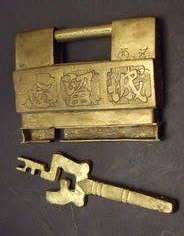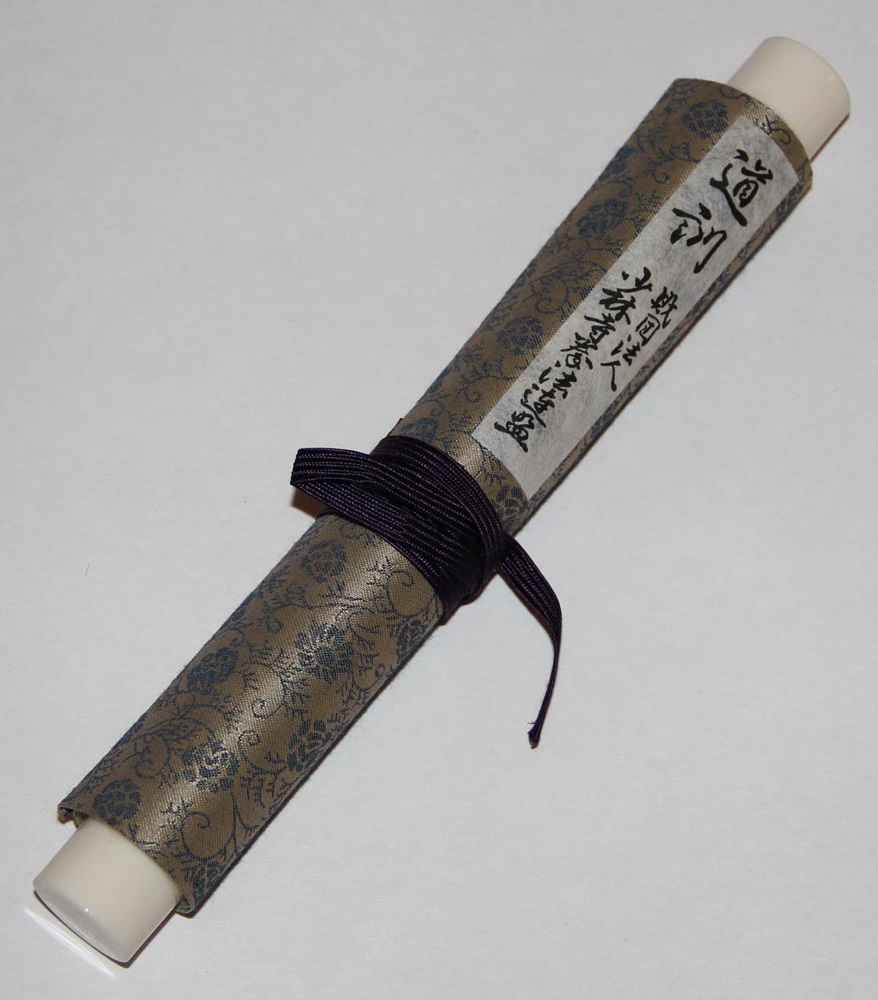
Zenteki-Tō is
usually the first kata or waza taught to
iaijutsu students at the Seishin-Kan. It
contains all five essential components of iaijutsu
technique in a simple and compact format: (1)
nukitsuke, (2) furikaburi, (3) kirioroshi, (4)
chiburui, and
(5) nōtō. It
also reveals several essential aspects of iaijutsu
strategy, so it should be practiced with both its
technical and strategic content in mind.
Zenteki-Tō
contains
the foregoing five elements in their simplest and most
basic format. Accordingly, it serves as an
encapsulation of the entire art of iaijutsu in
a single kata! Thus, it is important not
to dismiss Zenteki-Tō
as merely a beginner's training exercise to be abandoned
and forgotten by students as soon as they begin learning
"real" waza. Just the opposite!
Zenteki-Tō
(and/or Mae)
should be the most frequently performed and thoroughly
studied kata
in iaijutsu.
To master Zenteki-Tō
or Mae is to master iaijutsu iteself!
Initially, students should
focus their efforts on correct performance of its five
major technical components:
| • |
Shimomura-ha Nukitsuke(1) |
Minimal extraneous movement, maintain chakugan
(sightline), proper
positioning of the hands on the saya
and tsuka, correct koiguchi no
kirikata, pushing (not
pulling) the katana from the saya,
sayabiki (pulling the saya
rearward whilst pushing the tuska
forward, smooth, gradual acceleration, twisting
both hands 90 degrees anticlockwise to initiate
sayabanare (kissaki exiting the
sayaguchi), koshi-mawari
(turning the hips to facilitate sayabanare),
timing the lunging step forward with
sayabanare, "scissoring" the right hand to
perform the nukitsuke cut, hasuji o
tōsu (alignment of the blade with its
direction of travel), maintaining constant
pressure/threat (seme) to opponent's
seichusen (centre line), shizentai
(kamae [body position] that supports
and facilitates nukitsuke, and
finishing nukitsuke in a position (also
shizentai) that maximises seme
against the opponent and minimises openings for
counter-attack. |
| • |
Shimomura-ha Furikaburi(2) |
Initiate furikaburi with a slight
forward movement (for seme) of the
kissaki, then bending the right wrist
sharply and
pushing the kissaki rearward as if
trying to pierce the left ear with it, beginning
to raise the katana when the tsuba
is aligned between the eyes, left hand rising to
the tsuka just as the katana
is centered overhead, maintaining iaigoshi,
and timing the footwork so the feet come
together just as furikaburi is
completed. |
| • |
Shoden Kirioroshi(3) |
Initiate kirioroshi by tightening
the "pinky" fingers of both hands,
step forward with right foot into strong, stable
shizentai as the katana is moving (maai) make the
kissaki travel in the largest circular arc
possible, keep elbows at forehead level until
arms are fully extended at about a 45 degree
forward angle, use tsuka no nigiri kata
to ensure hasuji o tōsu, and
finish the cut with the tsukagashira
pointing at the navel and the top of the
kissaki at the same level as the bottom of
the habaki. |
| • |
Chiburui
(Ō-chiburi) |
Push the tsuka forward with the
right hand and move the left hand to the
saya where it is held by the obi,
then raise the kissaki slowly upward
and to the right until it reaches shoulder
level, then swing it quickly rearward and
downward until the fingertips of the right hand
are pointing at the top of the head directly
above the corner of the right eyebrow, pause
briefly, then swing the katana dowward
whilst quickly closing the right hand to stop it
suddenly. |
| • |
Shoden Nōtō(4) |
Grasp the sayaguchi and form a
koiguchi with the left hand, then—with a
slight forward movement for seme—sweep
the katana laterally across the body,
turning it edge-up and resting the mine
along the lower left forearm with the tusba
just in front of the koiguchi, push the
tsuka toward the right front whilst
pulling the saya rearward and turning
the hips leftward until the kissaki
drops onto the left forefinger, pause to ensure
that the kissaki is in the saya,
then slowly pull the saya forward and
the tsuka rearward so that the
tsuba contacts the koiguchi when
both hands are directly in front of the navel.
Hook the left thumb over the tsuba and
slide the right hand along the tsuka to
the tsukagashira. |
FOOTNOTES:
|
(1) |
Shimomura-ha nukitsuke, described above,
is used in all MJER Shoden Waza as well as in
the first eight (8) of the fifteen (15)
Eishin-Ryu Shitei Kata, including
Zenteki-Tō. |
|
|
(2) |
Shimomura-ha
furikaburi, described above,
is used in all MJER Shoden Waza as well as in
the first eight (8) of the fifteen (15)
Eishin-Ryu Shitei Kata, including
Zenteki-Tō. |
|
|
(3) |
Ō-chiburi, described above,
is used in eight (8) of the twelve (12) MJER Shoden Waza as well as in
five (5) of the fifteen (15)
Eishin-Ryu Shitei Kata, including
Zenteki-Tō, as well as six (6) of
the seven (7)
Shoden Battō-Hō. |
|
|
(4) |
Shoden nōtō, described above,
is used in all MJER Shoden Waza,
the first eight (8) of the fifteen (15)
Eishin-Ryu Shitei Kata, including
Zenteki-Tō, and all
seven (7) of the
Shoden Battō-Hō. |
|
***THE KEY TO MASTERY: don't just practice until
you start getting it right;
practice until you can no longer get
it wrong!
In iaijutsu there are no
named or standardised stances. Instead,
iaijutsu employs a principle called
shizentai. Shizentai
literally means "natural body," which in practical
application should be thought of as the ideal
body structure to support and facilitate whatever
technique is being performed. The correct
kamae for a given movement is determined by its
target, purpose, timing, distance from opponent, power,
and tactical considerations. Shizentai is
only "natural" in the sense that, after years of
diligent training, it becomes instinctive for the
skilled iaidōka—a part of our nature.
In all other respects, shizentai is decidedly
unnatural.
Having made that disclaimer,
there are four stances used in most styles of Japanese
karate-do that provide shoshinsha
(beginners) with useful guidelines for the various forms
of shizentai employed in iaijutsu:
musubi dachi, han-zenkutsu dachi, zenkutsu dachi,
and shiko dachi.
Musubi dachi
("closed stance") is highly similar to the shizentai
used in iaijutsu when standing still or
performing tachi-rei. In musubi dachi the
feet are flat on the floor or ground with the heels
together and the toes of both feet pointed outward at
about a 60 degree angle from each ofther. The body
is erect, but not stiff. The knees are slightly
flexed; not "locked." This kamae
is almost identical to the equivalent shizentai
used in Zenteki Tō at the beginning and end of the
kata,
so it has been used in the description above as a
shorthand
Han-zenkutsu dachi (meaning
"half front [leg] bent stance") is one of the
foundational stances of traditional karate-dō,
and it has several similarities to the shizentai used in
Zenteki Tō for nukitsuke, kirioroshi,
amd nōtō.
Key elements of han-zenkutsu dachi include:
(1) feet at shoulder-width (heel to heel), (2) distance between the
toes of the trailing foot and the heel of the leading
foot is the length of the student's shin, (3) front knee is bent so that the kneecap
is directly above the big toe, (4) rear leg is nearly "locked"
straight, (5) both feet are flat on the floor (neither
heel raised), (6) weight is distributed evenly (50%/50%)
between the front and rear feet, as well and left and
right sides, (7) back is straight
and posture erect, (8) shoulders are aligned with and
directly above the hips, and (9) slight forward pressure
is exerted against the front foot with equal backward
pressure against the rear foot.
Zenkutsu dachi (meaning
"front [leg] bent stance") is identical to
han-zenkutsu dachi in every respect except that
the distance between the
toes of the trailing foot and the heel of the leading
foot is the length of the student's shin plus the length
of one foot. Intermediate and advanced iaidōka
often perform nukitsuke with greater reach and
power than shoshinsha, so their shizentai
during nukitsuke may more
closely resemble zenkutsu dachi.
There is no kamae
in Zenteki Tō similar to shiko dachi,
so it will be described in connection with a kata
or waza to which it applies.
A kata (型) is an
pattern of movements intended for training in the
techniques and movements it contains, together with the
underlying principles that make them effective, but not
necessarily their practical use in combat.
Therefore, when performing this or any iaijutsu kata,
one must not only perform its movements correctly,
but also think about their purpose and how to maximize
their effectiveness. There is no term used in
iaijutsu for this analytical process, but it is
called
bunkai
and
ōyō
in karate-dō. It is
therefore vital to examine each movement in the kata
step-by-step (bunkai) in the context of its
purpose and use (ōyō)
to reverse-engineer how it serves to minimise exposure
to the enemy's attack and simultaneously maximise the
effectiveness of its countermeasures.
Performing bunkai with a
comprehension of
ōyō,
reveals how such principles as maai
(distance control), seme
(maintaining pressure on the opponent),
kamae (structure and posture),
kokyū (breath control), chakugan (eye
contact), kime (concentration
or focus), and zanshin
(awareness of surroundings) are applied to ensure
victory. The thousands of repetitions required to
perfect one's technical performance of a kata
also inculcate the mind with an understanding of its
underlying principles and infuse the spirit with
bushi damashii ("samurai spirit").


 When
learning a new waza (or kata, in
this case), it is important to remind
oneself of the adage: "Manabu no tame ni hyakkkai,
jukuren no tame ni senkai, satori no tame ni manga
okonau" (学ぶのために百回、熟練のために千回、悟りのために万回行う.).
When
learning a new waza (or kata, in
this case), it is important to remind
oneself of the adage: "Manabu no tame ni hyakkkai,
jukuren no tame ni senkai, satori no tame ni manga
okonau" (学ぶのために百回、熟練のために千回、悟りのために万回行う.).
